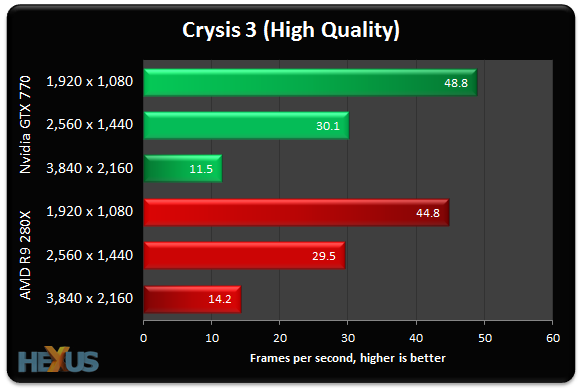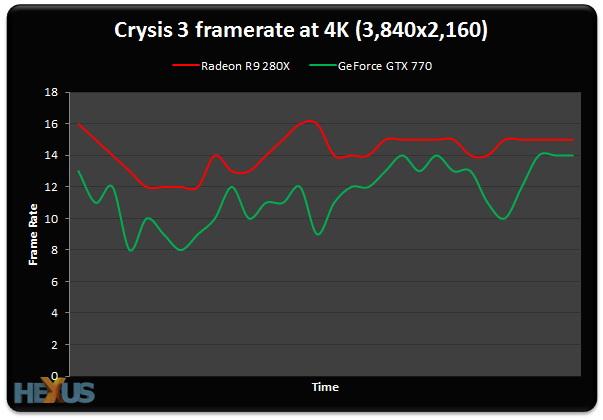The 4K conundrum, Crysis 3
AMD managed quite a clever move last Tuesday. The company practically rebranded its current mainstream and enthusiast graphics cards from Radeon HD 7000 to Radeon R9/R7. Yes, there is a tweak here and there, but for the most part, the new cards bear striking similarity to those on retailers' shelves for all of this year. The kicker, as far as AMD is concerned, is the lower prices and improved bang-for-buck when compared to equivalent cards from Nvidia.
Appreciating there's nothing really that new this time around - we'll have to wait for the Radeon R9 290/X for a grounds-up architecture - it's with some interest that we hear AMD messaging '4K' for the best Radeons. That resolution assertion makes more sense for the upcoming R290/X cards, but there's no harm in evaluating how the premier R9 card for now, the 280X, handles a 3,840x2,160-pixel resolution.
With that in mind, we've run the $299 R9 280X 3GB card up against a $399 GeForce GTX 770 2GB at 1,920x1,080, 2,560x1,440, and 3,840x2,160 resolutions. Our launch-day review has already shown relative performance at the two lower settings, with the Radeon more than holding its own against the more expensive Nvidia card. Both produce excellent performance at 1,920x1,080 and more than acceptable framerates at a 27in monitor-friendly 2,560x1,440, granted, but 4K is a fundamentally larger load that'll call the cards' framebuffer and render output ability into serious question.
We're using an Asus PQ321Q 4K monitor for testing. In-game image-quality settings range from high to ultra-high, and you can find a full breakdown of the testing methodology and equipment here. Note that we're continuing to use lots of GPU-bustin' antialiasing, to really put the hurt on the cards. The results will prove whether it's possible to game on a 4K-resolution screen, with top-notch settings, using sub-£300 cards - and they'll also set a foundation for the R9 290/X's 4K numbers in due course.
Let's begin by taking a look at performance in the most punishing game of all - Crysis 3.
 |
Crysis 3 is a beautiful-looking game that continues to tax high-end systems. We've FRAPS'd a 30-second section near the start of the game, with lashing rain, numerous reflections and full DX11 pomp on show.

Remember that image-quality settings don't change when spanning resolutions. These enthusiast-class cards do just fine at 1,920x1,080 but run into some difficultly at 2,560x1,440. 4K, however, represents a pixel-load that is 4x higher than 1,920x1,080, and it really does show.
At 4K, the game is dreadfully slow and laggy, to the point where it really is unplayable. Removal of the 4x AA setting isn't enough to increase performance to an average of over 25fps. From an academic point of view it's worth noting that the 3GB-equipped Radeon R9 280X loses less of its performance when moving from 2,560x1,440 to 3,840x,2,160.

Looking at the per-second results shows comparatively smoother gameplay for the Radeon, and examining the framebuffer usage shows that, with our settings, the 3GB framebuffer is completely filled. The GeForce GTX 770's 2GB buffer is naturally swamped, too. We absolutely need a lot more graphics horsepower to render the game at 4K.









